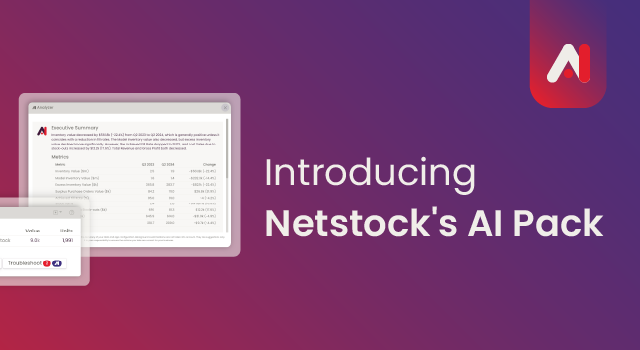What’s in this blog?
Days Inventory Outstanding (DIO) indicates the level of inventory management efficiency. A high DIO suggests that a company may have too much inventory and we know excess inventory is costly, raising inventory holding costs. These costs include the cost of warehouse space, insurance, interest, stock obsolescence, and spoilage. When demand planners understand DIO and its drivers, they can better manage inventory levels by matching sales with stockholding. This is done by driving sales higher or managing inventory ordering practices.
In this article, you’ll discover how DIO, as a key performance indicator, can help you drive down your inventory levels, reduce costs, and improve operational efficiency.
The connection to inventory turnover and operational efficiency
Inventory turnover is a measure of inventory flow. It’s the inverse of DIO, so a lower DIO suggests higher inventory turnover. Both show efficient inventory management. Modern-day businesses must constantly weigh low inventories with enough stock to cover variable demand.
Higher inventory turnover drives operational efficiency. Here’s how:
- Release capital: Use money invested in inventory for other operational or investment needs.
- Reduce inventory costs: Inventory costs drop as you use less warehouse space. There is less stock to insure and to write off due to spoilage and obsolescence.
On the downside, unless you account for service level requirements and variability of demand and supply, you risk running out of stock. Without careful planning, the lower the stock, the higher the stock-out risk.
Forecasting inventory using inventory days
DIO can help you to forecast inventory holding and you can use historical DIO to understand stockholding trends. If, for example, DIO has been dropping in recent months, it suggests that stock is moving through the system faster. This could indicate a sales increase, suggesting that the time has come to reassess the reorder points.
Some products are also subject to seasonal trends. If, for example, you sell knitwear, you would expect to sell more in the winter months than in summer. By looking at the DIO in previous seasons, you could predict adjusted inventory needs for the seasonal peaks and valleys.
Accurate demand forecasting is crucial for optimizing inventory, ensuring there is no excess stock or stock-outs. Stock-outs usually happen during demand surges, so you must put every effort into avoiding them. Dissatisfied customers may go to your competitors and not return, which could result in lost revenue now and in the future.
Inventory Turnover Ratio vs. Inventory Days
The inventory turnover ratio and inventory days are two sides of the same coin. They are both measures of good inventory management but offer different perspectives.
- Inventory turnover: measures how often the business sells all its inventory over the period, usually one year. Higher turnover means the stock is selling faster. Lower turnover may show an ordering or a sales and marketing problem.
- DIO: The average number of days a business takes to sell or use its inventory. A lower DIO means you are selling your inventory faster so less money is tied up in stock. A higher DIO shows you have too much money tied up in stock. This could affect your liquidity and your ability to meet short-term financial obligations. Operational costs will also rise with excess inventories as inventory holding costs increase.
How to calculate DIO?
The Days Inventory Outstanding formula follows:
- DIO = (Average inventory/COGS) x number of days
To calculate average inventory:
- Average inventory = (Opening Inventory + Closing Inventory)/2
Some businesses use a weighted average but that requires a more complex formula.
- COGS is the cost of buying or producing the product. It can be found on the income statement.
- The number of days depends on the period you measure. 365 days is most common, but you can also use 90 days for a quarter and 30 days for a month.
Considerations when calculating DIO
A good inventory turnover or DIO is industry-dependent. A grocery store will, for example, manage a much lower DIO than a second-hand car dealer. Because grocery sales cycle through more quickly – just as well since the goods are often perishable. The industry benchmark provides the best context for your situation. This is the figure against which you should measure your inventory performance.
Seasonality and production lead times will also affect the DIO. With seasonal sales, you will see a rise and fall in your DIO throughout the year. If your stock is well managed, you should see an increase in DIO just before your busy season and a reduction ahead of the slower period.
Extended production lead times may also lead to higher DIO. This is why industry benchmarks are so important.
Practical examples of DIO calculation
Here are two examples of DIO calculations in different industries:
Example 1: Clothing Boutique
- A clothing boutique has an opening inventory of $25,000 and $30,000 in closing inventory.
- The company wishes to measure its DIO for a month.
- COGS for the month is $40,000.
Simple Average Inventory
Average Inventory = ($25,000 + $30,000) / 2 = $27,500
DIO Calculation
DIO = ($27,500 / $40,000) x 30 days = 20.63 days
The boutique has a DIO of 20.63 days and a relatively quick inventory turnover. This is what you would expect in the retail fashion industry.
Electronics Manufacturer
- An electronics manufacturer has an opening inventory of $100,000.
- Its inventory closes at $120,000 for a quarter (90 days).
- COGS for the quarter is $250,000.
Simple Average Inventory
Average Inventory = ($100,000 + $120,000) / 2 = $110,000
DIO Calculation
DIO = ($110,000 / $250,000) x 90 days = 39.6 days
At 39.6 days, the DIO is higher than the clothing boutique DIO. This reflects the longer production lead times and larger order quantities often associated with electronics manufacturing.
How does DIO impact accounting?
The DIO affects both the balance sheet and income statements.
- Balance sheet: Inventory is a current asset so a high DIO will inflate the current assets on the balance sheet. Inventory value is directly affected by the DIO.
- Income statement: Higher inventory increases costs and lowers profit. Lost sales will result from stock-outs with a negative profit impact. These costs are directly affected by stockholding:
- Storage costs: Expect higher storage costs if the DIO is high.
- Obsolescence: The longer inventory takes to sell, the higher the risk of obsolescence.
- Shrinkage: The longer inventory takes to sell, the higher the risk of shrinkage from damage and theft.
The DIO has a significant impact on financial statements and performance metrics in the following areas:
- Return on assets (ROA): The ROA measures how effectively a business uses its assets to generate profits. If a large amount of capital is tied up in excess inventory, it may affect the company’s ability to generate profit. This shortfall will show up on the ROA.
- Inventory turnover: Higher inventory turnover leads to reduced inventory holding costs, improved cash flow, greater liquidity, and financial flexibility.
How does DIO impact supply chain planning?
The DIO can help you balance product availability and optimize inventory levels. Use the DIO to identify areas where excess stock exists. This information should inform order quantity adjustments and lead time reductions,both of which will lead to leaner inventory management practices.
From a cost perspective, a lower DIO is always desirable. Still, you can’t pursue lower inventories without considering the stock-out risk. A very low DIO could lead to a stock-out if demand surges or if there is a supply disruption. You must weigh the risks when driving stock levels down.
Most businesses keep buffer or safety stocks to guard against demand or supply variability. Longer lead times increase the stock-out risk and may affect the amount of safety stock employed.
How to use the DIO ratio to compare your business in your industry
The most effective way to use a DIO ratio is to compare yours with the industry average. DIO expectations differ across industries. For example, the grocery industry would expect a much lower DIO than the appliance industry.
Businesses in the same industry are your competitors and face similar circumstances. DIOs are, therefore, comparable in the same industry but not across industries.
Compare your DIO with similar-sized companies. A significant gap in DIO values may signify a problem with your inventory management practices. Identify the causes and act.
How is DIO used in inventory management?
DIO isn’t a measure of individual stock items. It measures total stock days. Efficient inventory management requires that you evaluate each stock item. Individual inventories must be planned from the bottom up based on desired service levels and demand and supply variability. These factors will differ from one item to the next.
Use an ABC analysis to sort items into those with the highest influence on the overall stock based on value and sales volumes. This will quickly drive down your total DIO. Focus on the A items, optimizing those items first. Leave the category C items to last.
Average days inventory outstanding
Calculate the average DIO to identify and gauge whether inventory is trending up or down. Trends highlight whether your inventory management practices improve over time. Analyze the trends and act. Significant DIO movements may result from changes in demand, problematic suppliers, or ordering practices.
The DIO can assist with strategic decisions like implementing JIT, collaborating with suppliers for Vendor Managed Inventories, or negotiating better supplier lead times. All these strategies should have a significant impact on DIO.
Days inventory plus days sales outstanding (DIO + DSO)
Analyzing Days Inventory Outstanding (DIO) and Days Sales Outstanding (DSO) both show the company’s efficiency in managing inventory and accounts receivable.
Here’s why:
- DIO: Measures how long it takes to sell or use inventory (inventory turnover).
- DSO: Measures how long it takes to collect payment after a sale (collection efficiency).
- Lower DIO levels: Indicate more efficient inventory management.
- Shorter collection time lower DSO: Suggests more effective credit policies and collection practices. The effect is an improvement in cash inflow.
Benefits of combined analysis
The combined analysis brings several benefits, including:
- Bottleneck identification: A high DIO with a high DSO could indicate inventory management and credit collection inefficiencies.
- An optimized Cash Conversion Cycle (CCC): The CCC measures how long you take to convert inventory and receivables into cash. Use the DIO and DSO to find ways to shorten the CCC and improve liquidity.
Difference between inventory turnover and inventory days
DIO and Inventory Turnover Ratio (ITR) are both crucial metrics for evaluating inventory efficiency. However, they offer different perspectives:
- DIO: Measures the average number of days the business needs to sell or use the entire inventory. A lower DIO indicates faster inventory turnover.
- Inventory Turnover Ratio (ITR): Measures how often your inventory is sold and replaced in a given period (usually a year). A higher ITR signifies faster inventory turnover.
Inventory optimization and DIO improvement: a multifaceted approach
With streamlined processes and optimized inventory, you can reduce your DIO to inventory benchmarked levels. To do this you must ensure that your on-hand inventory lines up with the demand at optimal service levels. Excess inventory increases costs. Optimized inventory requires a fine balance between excess stock and insufficient inventory to meet customer needs.
Use the following inventory optimization techniques to optimize your inventory:
- Demand forecasting: Accurate forecasting enables you to plan and order more effectively. A good forecast minimizes the risk of stock-outs or excess inventory.
- Just-in-Time (JIT) Inventory management: This tried and tested approach reduces inventory by ensuring that materials arrive only when needed for production.
- SKU rationalization and product mix optimization: Identify and remove slow-moving or obsolete stock-keeping units (SKUs). You’ll free up storage space, reduce carrying costs, and improve inventory turnover.
- Technology and data analytics: Advanced tools analyze vast amounts of inventory data. Data analytics can identify trends and optimize replenishment cycles. Use it for data-driven decision-making and improved inventory management practices.
- Streamlining the supply chain: Reduce lead times and production to improve efficiency and lower DIO. Streamline the supply chain through supplier collaboration, shared data, optimized transportation routes, and efficient internal processes.
- Continuous tracking and adjustment: Inventory optimization is not a one-time event. Sustained DIO improvement needs ongoing monitoring. Adjust your inventory strategies to adapt to the ever-changing environment. your inventory management practices must respond as market conditions and customer demand evolve.
Gain a competitive advantage with inventory optimization
Your business can achieve a significant competitive advantage using inventory optimization strategies and techniques. Lower DIO translates to reduced carrying costs, improved cash flow, and improved sales by lowering the stock-out risk.
Optimized inventory supports sales, improves revenue, and reduces costs. Efficient inventory management releases capital that you can use for other business investments or operational expenses – an enviable position your competitors will find difficult to match.




